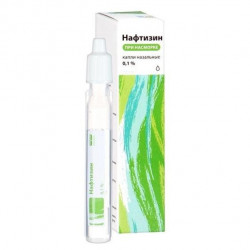



 All payments are encrypted via SSL
All payments are encrypted via SSL
 Full Refund if you haven't received your order
Full Refund if you haven't received your order
Alpha-adrenal stimulating agent, has a fast, pronounced and long-lasting vasoconstrictor effect on the vessels of the mucous membranes (reduces swelling, hyperemia, exudation). Relieves nasal breathing in rhinitis. After 5-7 days, tolerance arises.
Acute rhinitis, hay rhinitis, sinusitis, eustachitis, laryngitis, laryngeal edema of allergic origin, laryngeal edema during irradiation, hyperemia of the mucous membrane after operations on the upper respiratory tract, chronic conjunctivitis, asthenopic disorders, as an auxiliary agent for conjunctivitis of bacterial origin. To stop nasal bleeding, to facilitate rhinoscopy.
In otolaryngology: intranasal (in each nasal passage), adults are prescribed 1-3 drops of a 0.05-0.1% solution 3-4 times a day. In children, a 0.05% aqueous solution (or a 0.025% solution is used, diluting the 0.05% solution with distilled water): from 1 to 6 years - 1-2 drops, from 6 to 15 years - 2 drops 1-3 times a day. For diagnostic purposes, after cleaning the nose, drip 3-4 drops into each nasal passage or insert a tampon dipped in 0.05% aqueous solution and leave for 1-2 minutes; With swelling of the vocal cords, inject 1-2 ml of solution in the form of a spray or in small doses with a laryngeal syringe; for bleeding, swabs moistened with a 0.05% solution.In ophthalmology: 1-2 drops of a 0.05% solution in the conjunctival cavity, 1-3 times a day. In urology: a urethral catheter at 0.5-1. 5 ml of a 0.1% sterile aqueous solution is applied to a stone. As an additional tool for surface anesthesia - 2-4 drops per 1 ml of local anesthetic.
Nausea, tachycardia, headache, increased blood pressure, reactive hyperemia, swelling of the nasal mucosa. Irritation, when used for more than 1 week - swelling of the nasal mucosa, atrophic rhinitis. Overdose. Symptoms: decrease in body temperature, bradycardia, increased blood pressure. Treatment: symptomatic.
Hypersensitivity; arterial hypertension, marked atherosclerosis, hyperthyroidism, children's age (up to 1 year), chronic rhinitis, serious eye diseases, diabetes mellitus; simultaneous administration of MAO inhibitors and a period of up to 14 days after the end of their use.
May have a resorptive effect. It is acceptable to sterilize the solution of the drug (after removing the drop valve and gasket) in saturated water vapor at a temperature of 115-116 degrees C for 30 minutes. With prolonged use, the severity of the vasoconstrictive action gradually decreases (the phenomenon of tachyphylaxis), and therefore it is recommended to take a break for several days after 5-7 days of use.
It should not be used simultaneously with MAO inhibitors or within 10 days after the end of their use.Slows down the absorption of local anesthetic substances (lengthens their action when performing surface anesthesia).
List B. In the dark spot.
